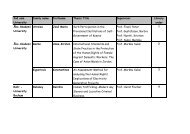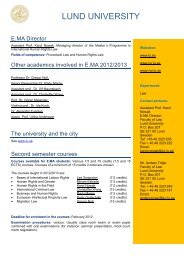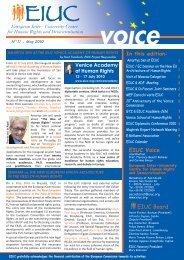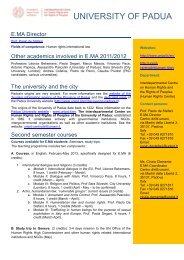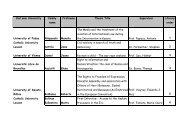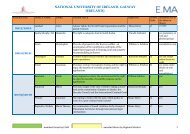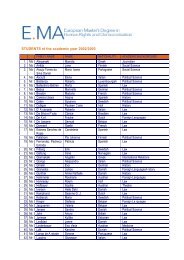study human rights mainstreaming in eu's external relations - EIUC
study human rights mainstreaming in eu's external relations - EIUC
study human rights mainstreaming in eu's external relations - EIUC
Create successful ePaper yourself
Turn your PDF publications into a flip-book with our unique Google optimized e-Paper software.
DG EXPO Policy Department<br />
By the end of 2004, tra<strong>in</strong><strong>in</strong>g had cont<strong>in</strong>ued and fact sheets had been prepared. By l<strong>in</strong>k<strong>in</strong>g<br />
with country desks, delegations and heads of mission, the <strong>human</strong> <strong>rights</strong> unit has proactively<br />
tried to re-focus political dialogues around <strong>human</strong> <strong>rights</strong> issues. In some cases, <strong>human</strong> <strong>rights</strong><br />
dialogues have contributed to the <strong>ma<strong>in</strong>stream<strong>in</strong>g</strong> of <strong>human</strong> <strong>rights</strong> with<strong>in</strong> wider regional<br />
strategies, as <strong>in</strong> the case of Central Asia.<br />
In this respect, what the EU has achieved is considerable. Putt<strong>in</strong>g <strong>in</strong> place <strong>ma<strong>in</strong>stream<strong>in</strong>g</strong> is<br />
not an easy task for the EU. Eventually, it is more difficult for the EU than the UN, due to the<br />
quasi-federal nature of the EU and the complexities and different <strong>in</strong>terplays of competences<br />
and functions of actors which characterise the different policies related to <strong>external</strong> <strong>relations</strong>,<br />
from the CFSP to, potentially, the <strong>external</strong> dimensions of first and third pillar actions. Overall,<br />
the clearest achievements have been made concern<strong>in</strong>g the ‘political’ dimension of <strong>human</strong><br />
<strong>rights</strong> <strong>ma<strong>in</strong>stream<strong>in</strong>g</strong> (<strong>ma<strong>in</strong>stream<strong>in</strong>g</strong> <strong>human</strong> <strong>rights</strong> <strong>in</strong>to political dialogues and the<br />
implementation of some thematic <strong>human</strong> <strong>rights</strong> guidel<strong>in</strong>es). On the other hand, <strong>human</strong><br />
<strong>rights</strong> <strong>ma<strong>in</strong>stream<strong>in</strong>g</strong> has seemed to be less satisfactory <strong>in</strong> specific thematic areas, such as<br />
the area of development cooperation, where <strong>in</strong> fact the UN has so far seemed to have<br />
pursued a more consistent <strong>human</strong> <strong>rights</strong>-based approach. Start<strong>in</strong>g from this very general<br />
assessment, <strong>in</strong> the follow<strong>in</strong>g more specific shortcom<strong>in</strong>gs and po<strong>in</strong>ts of ambiguity are<br />
identified.<br />
Ma<strong>in</strong>stream<strong>in</strong>g all <strong>human</strong> <strong>rights</strong><br />
There appears to be a tension between the EU commitment to all <strong>human</strong> <strong>rights</strong> and the<br />
almost exclusive focus on specific sets and issues of <strong>human</strong> <strong>rights</strong>, usually related to civil and<br />
political <strong>rights</strong>. This emerges, for example, <strong>in</strong> the tools for <strong>ma<strong>in</strong>stream<strong>in</strong>g</strong>. On the one hand,<br />
the EU reaffirms <strong>in</strong> many <strong>in</strong>stances the pr<strong>in</strong>ciple of <strong>in</strong>divisibility and <strong>in</strong>terdependence of<br />
<strong>human</strong> <strong>rights</strong>. It also considers that, with<strong>in</strong> <strong>human</strong> <strong>rights</strong> dialogues, the partner country<br />
accession to all ma<strong>in</strong> <strong>human</strong> <strong>rights</strong> treaties, <strong>in</strong>clud<strong>in</strong>g the covenant on economic, social and<br />
cultural <strong>rights</strong>, should be a matter of discussion. On the other, when discuss<strong>in</strong>g, for example,<br />
the practical arrangements for <strong>human</strong> <strong>rights</strong> dialogues, the Council urges that the countries<br />
<strong>in</strong>volved <strong>in</strong> the dialogues should <strong>in</strong>clude <strong>in</strong> their delegations “representatives of the various<br />
<strong>in</strong>stitutions and M<strong>in</strong>istries responsible for <strong>human</strong> <strong>rights</strong> matters, such as Justice and Interior<br />
M<strong>in</strong>istries, the police, prison adm<strong>in</strong>istration, etc.” 84 without, <strong>in</strong> fact, nam<strong>in</strong>g any m<strong>in</strong>istry or<br />
body concerned with social and economic policies, or cultural issues. The same priority to<br />
civil and political <strong>rights</strong> is evident also <strong>in</strong> relation to the EIDHR. With<strong>in</strong> objective 1, for<br />
example, the activities to be supported cover almost exclusively the core ‘<strong>rights</strong> to freedom’<br />
of thought, religion, expression, <strong>in</strong>formation, association and movement. Also the four areas<br />
of activity with<strong>in</strong> objective 2 focus overwhelm<strong>in</strong>gly on <strong>rights</strong> complement<strong>in</strong>g liberal<br />
democratic regimes.<br />
Overall, what seems to lack is a more comprehensive consideration of <strong>human</strong> <strong>rights</strong> that<br />
<strong>in</strong>cludes economic, social and cultural <strong>rights</strong>. This could expla<strong>in</strong> why the ‘socio-economic’<br />
dimension of <strong>human</strong> <strong>rights</strong> <strong>ma<strong>in</strong>stream<strong>in</strong>g</strong> has been less emphasised. The tra<strong>in</strong><strong>in</strong>g materials<br />
provided by the Commission are heavily focused on the above-mentioned ‘political’<br />
dimension of <strong>ma<strong>in</strong>stream<strong>in</strong>g</strong>, <strong>in</strong>clud<strong>in</strong>g the <strong>human</strong> <strong>rights</strong> guidel<strong>in</strong>es. This is certa<strong>in</strong>ly<br />
84 Council of the European Union (2001) “European Union guidel<strong>in</strong>es on Human Rights dialogues”,<br />
para.7<br />
42



